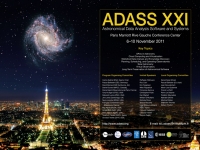Pierre Fernique (Centre de Donnees astronomiques de Strasbourg), Thomas Boch (CDS)
Abstract
Some new developments at CDS, notably Aladin allsky V7 and the new cross-match tool for very large catalogues, led the CDS team to define and use a new method to describe regions of the sky.
We aimed at addressing use cases such as:
1. find the common area between multiple catalogues;
2. which objects of my list have potential counterparts in this dataset;
3. visualize the coverage of a survey.
The major constraint is to answer in a very short time, ie a few milliseconds, the following question: ′Does this data set intersect such or such region of the sky?′.
Astronomical data bases are obviously able to solve this problem. Usually the search region is a cone of a few arc-minutes radius, and typical response times are a few seconds, growing proportionally with the area covered by the cone. These response times are mainly due to the data base indexation method and also to the conversions and computations of spherical distances required to solve this kind of request.
In order to shorten this delay, we opted for a static and homogeneous description of data sets using the sky tesselation defined by the HEALPix standard. HEALPix is a sky pixelisation method based on 12 diamonds, recursively subdivided into four sub-diamonds. HEALPix is well known notably by the users of the WMAP or PLANCK missions. It has the advantage, over its competitor HTM, to provide equal surface cells for a given level, and a constant computation time for any level.
Our key idea is to use such a system to define a region of the sky by the list of corresponding HEALPix cells, grouping them hierarchically in order to reduce the volume required by the description. We called this system ′Multi-Order Coverage Map′ or ′MOC′. With the help of HEALPix developers, we have defined a FITS encoded format and an ASCII format in order to easily manipulate them. We also create a Java library for writing, reading, comparing and also to compute some simple operations such as union and intersection.
We generated the MOC for each VizieR catalog (~ 10,000) and for some image surveys available in Aladin V7 (~ 50).
These MOCs are already available via classical URLs and can be visualised in the Aladin beta version, which already supports the MOC format.
Such a system shared by several data centers, or even being accepted as a standard at the IVOA level, would significantly improve in the short term a lot of VO tools, for instance TOPcat, the well-known tool for handling astronomical tables. Currently, this tool generates more than half of the VizieR queries mainly to cross-correlate the user data set with such or such VizieR catalog. It would be infinitely more effective if TOPcat compared first the both MOCs before operating the source cross-identification in order to consider only the sources present in the intersection of the data sets. This would reduce considerably the number of unnecessary queries.
In our poster, we present the potential of such a method. We detail the encoding formats and we illustrate the usage of such coverage maps in the latest Aladin prototype.
Poster in PDF format
Paper ID: P043
Poster Instructions
|

